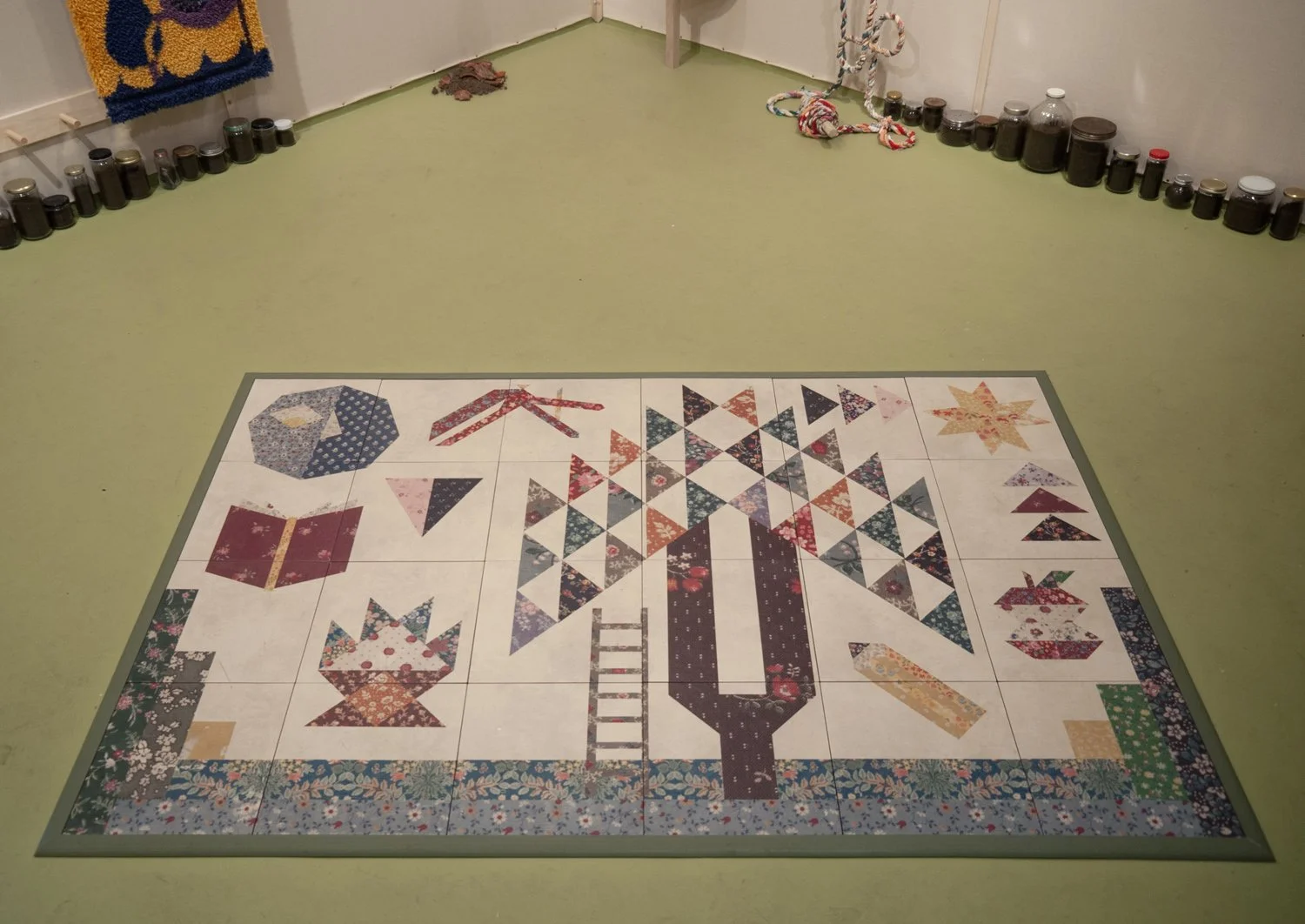
WE KNOW THAT WE KNOW
Installation is location at Field Projects in Chelsea, NYC. Opens October 26, 2025 and closes November 22, 2025.
Curated by Jacob Rhodes
Press Release:
In We Know That We Know, Vermont-based artist Chiara No presents ordinary domestic things that are transformed into knotted forms of dissent, welded with double meanings and carved references to forgotten or distorted histories. By redressing stories and histories that have been maliciously misremembered or erased, Chiara calls attention to the power of the everyday as storytellers: the rug, the bell, the spoon, the chair. Each one is envisioned as active participants with perspectives and agendas.
Central to the exhibition is the idea of gossip; not as idle talk, but as a whisper network, shared stories, a system of care and survival historically used by women and marginalized communities. This “good gossip” becomes a form of resistance—a way to protect, uplift, and comfort. It is knowledge passed through coded language and material, and a defiant archive against official histories. Chiara critiques how domestic items can be a source of protection, while these items, if found in the wrong place in the home, can be weaponized by those in power. Bells, for example, are found on top of church steeples to call in the holy ghost but if found in the wrong part of a home, could be a sign of a devil’s altar.
Chiara hangs her work using the vernacular of home, nodding to the utility of Shaker furniture and in spirit, calling on their radical experiments in communalism. She thinks about how, through our stories, our gossip, we share and learn from each other and use the past to reconnect us with the present; reminding us how we tell stories to shape the future.
Chiara’s rugs tell a story about a type of person. They tell a story that feels repetitive throughout Western histories and directly affect today’s body politic*—demonizing the other instead of finding empathy, removing knowledge holders when the truths are inconvenient, seeing the past as a way to predict the future but no one listens. Her rugs function as a protective barrier—their soft borders protecting whether they are on the wall, floor or resting on one's shoulders.
Chiara’s rug beaters tell the story of the English language and how some words over the centuries and millennia have been distorted and weaponized against those who found identity and strength in that word. The head of the beater is a specific word codified into drawing and sculpted into steel. The handles are found and constructed forms that relate to the innocuous origin of the now maligned word. The rug beater is a millenniums old cleaning tool. Creating the beater is an act of cleaning the word.
Chiara’s bells tells a story of an individual who could be a real or supernatural person, who was demonized and dehumanized in Western historical writings, myths, and fairy tales to advance the dominant cultural agenda of their time. By ringing them, they know we are here; By ringing them, they can tell us their stories; By ringing them; we can tell their stories.
In the act of sharing our stories—gossip—Chiara invited three artists to contribute something intentional for this exhibition: George Sawyer, a Vermont-based artist and Windsor chair maker, constructed his take on a gossip chair that invites a pair to sit closely and share knowledge or stories together. Its encompassing arm-bow creates a safe space for conversation, drawing reference to a bassinet and the roots of the word “gossip” to midwifery and motherhood. Julien Birch, a Vermont-based artist, paints surreal interior spaces that reflect on memory and trauma through the use of uncanny distortions of everyday objects and spaces. Cait McCormack, a Philadelphia-based fiber sculptor, created objects embodying the act of shooting their memories into outer space only for them to return, compressed and altered by the conditions of the unknown.
*body politic: noun. the dominant people of a nation, state, or society considered collectively as an organized group of citizens.
Bibliography:
Basile, Giambattista, et al. Giambattista Basile’s The Tale of Tales, or Entertainment for Little Ones. Wayne State University Press, 2014.
Bezovska, Albena. “The Spoon in Folk Rituals and Beliefs.” Folklore, БНР Новини, 22 Oct. 2014, bnr.bg/en/post/100475607/the-spoon-in-folk-rituals-and-beliefs.
Bryson, Bill. At Home: A Short History of Private Life. Anchor Books, 2011.
Burns, Ken, director. The Shakers--Hands to Work, Hearts to God. Direct Cinema, 1984.
“Cassandra: Priestess of Troy.” The Ancients Podcast, episode 534, History Hits, 12 Apr. 2025.
Clegg, Sarah. Women’s Lore: 4,000 Years of Sirens, Serpents and Succubi: 4,000 Years of Sirens, Serpents and Succubi. 2024.
Daly, Mary. Gyn/Ecology. Beacon Press, 1990.
Davies, Surekha. Humans: A Monstrous History. University of California Press, 2025.
Farber, Walter. Lamastu: An Edition of the Canonical Series of Lamastu Incantations and Rituals and Related Texts from the Second and First Millennia B.C. Eisenbrauns, 2014.
Federici, Silvia, and Peter Linebaugh. Re-Enchanting the World: Feminism and the Politics of the Commons. PM Press, 2019.
Federici, Silvia. Witches, Witch-Hunting, and Women. PM Press, 2018.
Geller, Markham J. Healing Magic and Evil Demons: Canonical Udug-Hul Incantations. De Gruyter, 2016.
Jewish Voice for Peace Academic Advisory Council. “Rejecting Project Esther: Understanding Christian and White Nationalism as Racism and Antisemitism.” Contending Modernities, 6 May 2025, contendingmodernities.nd.edu/global-currents/jvp-rejecting-project-esther/.
Klein, Melanie. Envy and Gratitude & Other Works, 1946-1963, Chapter 15: Some Reflections of The Oresteia. Dell, 1977.
Lau, Kimberly J. Specters of the Marvelous: Race and the Development of the European Fairy Tale. Wayne State University Press, 2025.
“Lilith: Mesopotamian Demoness.” The Ancients Podcast, episode 307, History Hits, 29 Apr. 2023.
McKinney, Kelsey. You Didn’t Hear This from Me: (Mostly) True Notes on Gossip. Grand Central Publishing, 2025.
“Project 2025’s Other Project.” The Daily, The New York Times, 16 July 2025.

Images displayed from left to right, starting at the entrance of the gallery.




































WE KNOW THAT WE KNOW
Installation is location at Field Projects in Chelsea, NYC. Opens October 26, 2025 and closes November 22, 2025.
Curated by Jacob Rhodes
Press Release:
In We Know That We Know, Vermont-based artist Chiara No presents ordinary domestic things that are transformed into knotted forms of dissent, welded with double meanings and carved references to forgotten or distorted histories. By redressing stories and histories that have been maliciously misremembered or erased, Chiara calls attention to the power of the everyday as storytellers: the rug, the bell, the spoon, the chair. Each one is envisioned as active participants with perspectives and agendas.
Central to the exhibition is the idea of gossip; not as idle talk, but as a whisper network, shared stories, a system of care and survival historically used by women and marginalized communities. This “good gossip” becomes a form of resistance—a way to protect, uplift, and comfort. It is knowledge passed through coded language and material, and a defiant archive against official histories. Chiara critiques how domestic items can be a source of protection, while these items, if found in the wrong place in the home, can be weaponized by those in power. Bells, for example, are found on top of church steeples to call in the holy ghost but if found in the wrong part of a home, could be a sign of a devil’s altar.
Chiara hangs her work using the vernacular of home, nodding to the utility of Shaker furniture and in spirit, calling on their radical experiments in communalism. She thinks about how, through our stories, our gossip, we share and learn from each other and use the past to reconnect us with the present; reminding us how we tell stories to shape the future.
Chiara’s rugs tell a story about a type of person. They tell a story that feels repetitive throughout Western histories and directly affect today’s body politic*—demonizing the other instead of finding empathy, removing knowledge holders when the truths are inconvenient, seeing the past as a way to predict the future but no one listens. Her rugs function as a protective barrier—their soft borders protecting whether they are on the wall, floor or resting on one's shoulders.
Chiara’s rug beaters tell the story of the English language and how some words over the centuries and millennia have been distorted and weaponized against those who found identity and strength in that word. The head of the beater is a specific word codified into drawing and sculpted into steel. The handles are found and constructed forms that relate to the innocuous origin of the now maligned word. The rug beater is a millenniums old cleaning tool. Creating the beater is an act of cleaning the word.
Chiara’s bells tells a story of an individual who could be a real or supernatural person, who was demonized and dehumanized in Western historical writings, myths, and fairy tales to advance the dominant cultural agenda of their time. By ringing them, they know we are here; By ringing them, they can tell us their stories; By ringing them; we can tell their stories.
In the act of sharing our stories—gossip—Chiara invited three artists to contribute something intentional for this exhibition: George Sawyer, a Vermont-based artist and Windsor chair maker, constructed his take on a gossip chair that invites a pair to sit closely and share knowledge or stories together. Its encompassing arm-bow creates a safe space for conversation, drawing reference to a bassinet and the roots of the word “gossip” to midwifery and motherhood. Julien Birch, a Vermont-based artist, paints surreal interior spaces that reflect on memory and trauma through the use of uncanny distortions of everyday objects and spaces. Cait McCormack, a Philadelphia-based fiber sculptor, created objects embodying the act of shooting their memories into outer space only for them to return, compressed and altered by the conditions of the unknown.
*body politic: noun. the dominant people of a nation, state, or society considered collectively as an organized group of citizens.
Bibliography:
Basile, Giambattista, et al. Giambattista Basile’s The Tale of Tales, or Entertainment for Little Ones. Wayne State University Press, 2014.
Bezovska, Albena. “The Spoon in Folk Rituals and Beliefs.” Folklore, БНР Новини, 22 Oct. 2014, bnr.bg/en/post/100475607/the-spoon-in-folk-rituals-and-beliefs.
Bryson, Bill. At Home: A Short History of Private Life. Anchor Books, 2011.
Burns, Ken, director. The Shakers--Hands to Work, Hearts to God. Direct Cinema, 1984.
“Cassandra: Priestess of Troy.” The Ancients Podcast, episode 534, History Hits, 12 Apr. 2025.
Clegg, Sarah. Women’s Lore: 4,000 Years of Sirens, Serpents and Succubi: 4,000 Years of Sirens, Serpents and Succubi. 2024.
Daly, Mary. Gyn/Ecology. Beacon Press, 1990.
Davies, Surekha. Humans: A Monstrous History. University of California Press, 2025.
Farber, Walter. Lamastu: An Edition of the Canonical Series of Lamastu Incantations and Rituals and Related Texts from the Second and First Millennia B.C. Eisenbrauns, 2014.
Federici, Silvia, and Peter Linebaugh. Re-Enchanting the World: Feminism and the Politics of the Commons. PM Press, 2019.
Federici, Silvia. Witches, Witch-Hunting, and Women. PM Press, 2018.
Geller, Markham J. Healing Magic and Evil Demons: Canonical Udug-Hul Incantations. De Gruyter, 2016.
Jewish Voice for Peace Academic Advisory Council. “Rejecting Project Esther: Understanding Christian and White Nationalism as Racism and Antisemitism.” Contending Modernities, 6 May 2025, contendingmodernities.nd.edu/global-currents/jvp-rejecting-project-esther/.
Klein, Melanie. Envy and Gratitude & Other Works, 1946-1963, Chapter 15: Some Reflections of The Oresteia. Dell, 1977.
Lau, Kimberly J. Specters of the Marvelous: Race and the Development of the European Fairy Tale. Wayne State University Press, 2025.
“Lilith: Mesopotamian Demoness.” The Ancients Podcast, episode 307, History Hits, 29 Apr. 2023.
McKinney, Kelsey. You Didn’t Hear This from Me: (Mostly) True Notes on Gossip. Grand Central Publishing, 2025.
“Project 2025’s Other Project.” The Daily, The New York Times, 16 July 2025.
Images displayed from left to right, starting at the entrance of the gallery.






































